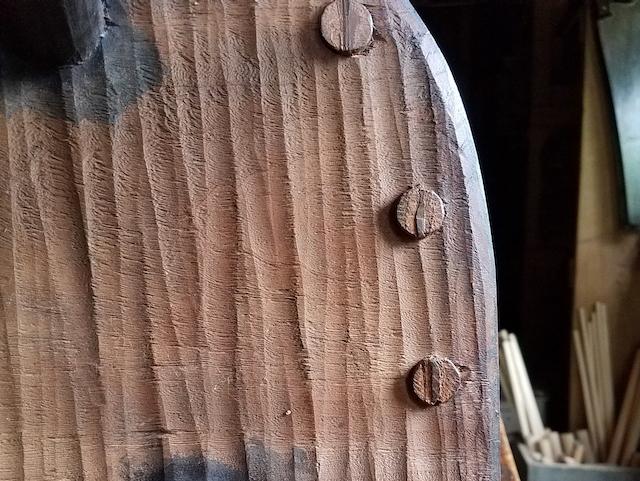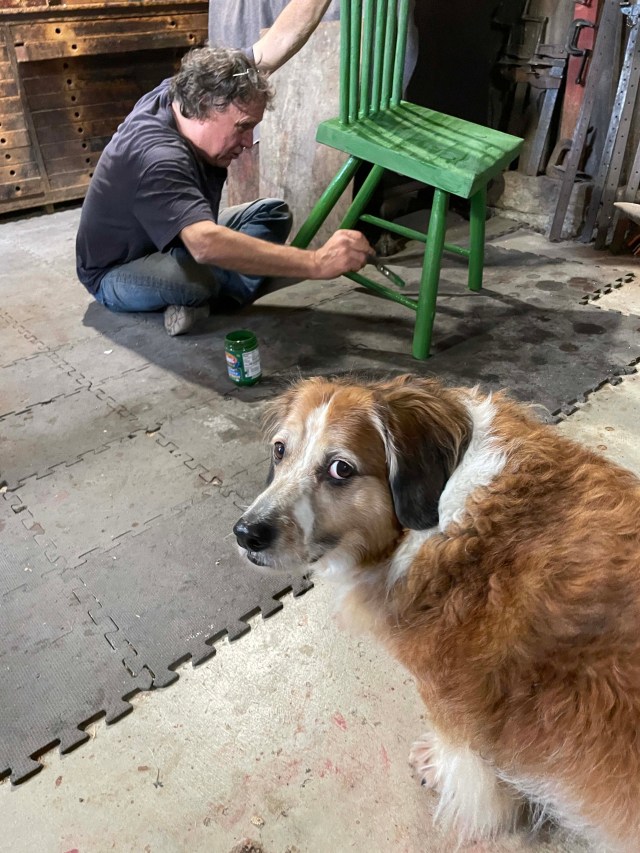
Touching a surface that had been gently used for hundreds of years is something that cannot be easily replicated. And so, for the most part, I’ve never attempted it.
Why? I’ve seen hundreds of new pieces of furniture that have been “aged” through chemical and physical abuse. And to be honest they reminded me of people who had also been through those kinds of abuse. Empty – and a bit wanting.
It wasn’t until I met John Porritt, a professional chairmaker and finisher, that I encountered surfaces that had the same magical quality of an antique from 1790. It’s not that John was trying to fool me with his finishes. John was completely upfront about his work. But his finishes had the same spirit of old work.

Everything – and I mean everything – has been mellowed. Nothing shouts or screams or insists upon itself. The surfaces are there. They are believable. And they feel… human.
That’s because they are made with great care and zero cynicism.
Most surprising was the amount of careful burnishing that goes into John’s work. After three seconds of thought, this should be obvious. Furniture surfaces aren’t just abraded by the years of use. They are also gently compressed by everything from your tailbone to the rivets on your pants.

The tools for burnishing are pretty simple. A couple deer antlers. The shaft of a screwdriver. A chainmail pot scrubber and a few special pebbles. But what isn’t simple is how they are applied during the process and how often. Burnishing isn’t like a seal coat of shellac (“And now we burnish!). Instead it is an ongoing process throughout finishing. Different amounts of burnishing on different areas of the piece.
The subtle glow and shine that results from the work is its own reward.

Also fascinating is how John applies and removes color. Again, color isn’t just a single stage in the process. It is added and removed (using a variety of simple processes) to produce surfaces that are almost luminous, and that fade into the surfaces above and below the color.
If all this sounds too complex or way over your abilities, it’s not. Nothing in “The Belligerent Finisher” is difficult. Or beyond the ability of a passionate beginner. Indeed, it is the combination of these simple and individual steps that is the genius of John’s work.

If you know my work, you know I make no effort to tone down the crisp lines and newness of my work. I do this out of honesty. But at the same time, my goal is to create work that reduces your blood pressure (read the chapter “Seeing Red” in “The Anarchist’s Design Book”). So John’s work has me thinking – a lot.
With one of my recent chairs I started burnishing its surfaces, much like he describes in “The Belligerent Finisher.” It wasn’t difficult. It was actually pleasurable. And after some paint and black wax, I could feel the difference the burnishing made. Everything was just a little more wanting to be touched.
I’m not one to make sudden changes in my work. I am completely iterative. But I can feel John’s ideas scratching at the back of my brain. His chairs and his surfaces are just too beautiful to ignore.
“The Belligerent Finisher” is both a revelation and a bargain at $21. You can read it in an afternoon. But it will stick with you for a lot longer.
— Christopher Schwarz



I’m torn. Sitting in (or wearing) something that is well-worn is very comfortable. But it is often not attractive. In contrast, something with sharp, crisp lines is beautiful, but often not comfortable.
I almost always default to comfort. But it’s a quandary.
Reminds me of knights in armor. Good idea!
As a professional refinisher/restorer i was initially aghast at the concept in the book…and then i read it…and was inspired by the thoughtful application of color, wear and finish….so much so that i am determined to attempt his techniques on a few chairs i have hanging around the shop. Great book, and solid craftsmanship….thanks
Bought the book. Read it cover to cover in a day (not a huge task). Great guide,that I hope to apply in my own work. Already bought a burnishing potscrubber!
Thank you Mr Porritt, and thank you Lost Art, for sharing.
It’s interesting. I think about it like a pair of jeans. New ones are crisp, you break them in according to your wear, your use, your body. You can buy ones that are enzyme washed for softness, pre-distressed for comfort (and the look of hard-won patina) – but they might be more comfortable.
Over the long term of course they will wear faster, which is where the analogy fails, as the chair won’t meaningfully “wear faster”. I get that there are beautiful moments to be found in distressing the chair, burnishing it for softness, a certain handfeel, but I don’t I guess exactly understand what would motivate a craftsperson to replicate wear that has to be earned. What does it do for the chair and the craftsperson so to speak, vs. what it does for the client. No one said it has to be an authentic experience per se, and it’s interesting to find new avenues. I guess at the end of this missive, I think it’s important that folks do the work of using things to create a patina because it creates a very real and lasting connection to physical objects that I don’t think really comes any other way.
Chairs do not need to earn anything.It’s utterly a matter of personal taste. I personally find new, shiny Windsor chairs fugly. I have a set of 1815’s in my home; I have a 1790’s bowback, and I have three I have made that appear age appropriate.
To each his own. Make them look old; make them look new; paint them fluorescent with LEDs under the seat like a lowride, so long as it brings you joy. All that truly matters is that it makes you snd yours happy.
Agreed, that the appearance does not need to be earned.
I went to a ballgame a few weeks ago. There had to be about 10,000 women in the crowd, and not a single one wore jeans without holes and rips. I’m willing to bet not one of them got that way from roofing or plumbing.
It’s aesthetics. If you like the look, do it.
Am I the only one that thinks the dog in the last photo has some amazing stories to tell…?
I’m sure it does, but my reading of that look is: ” If you try to take one more step towards John, you are going to regret it”
This is one of my favorite photos from the shoot. The dog looks smarter and wiser than all of us.
It’s a great shot. Brought back dog encounter memories at clients homes. The good ones and the bad ones.
I thought the look says “Yeah. I might have chewed that stretcher a little.”
I’m more inclined to “I told him green was not a good choice, but would he listen?!”
The book’s techniques (several of which are new to me) are also useful in sculptural work. As I try to capture the millions of years of wear in the southwest desert I expect the book to be a great help.
Another book on my short list to purchase come next payday. You’re going to need to start to ship your books in brown unmarked packaging. My wife is getting wise to my LAP addition. Can you please stop making such useful books?
“I’ve seen hundreds of new pieces of furniture that have been “aged” through chemical and physical abuse. And to be honest they reminded me of people who had also been through those kinds of abuse. Empty – and a bit wanting.”
This probably should have stayed in the drafts. There’s ways to talk about how you feel about other chair finishes that don’t involve being callous and judgmental about addicts and abuse survivors (?). “Empty and a bit wanting”. What a lousy thing to say without any prompting at all!
Hmm. Now, who’s being judgmental ? It’s his personal assessment. I agree, having seen far, far more of the referenced individuals than you. You are free to disagree.
If you thought about it even momentarily, it would be obvious that the problem lies not with judgment itself, but with its application outside of any sense of compassion or basic decency in service of punching down. To do so is to take what might charitably be called an ill-considered or mean-spirited position. In Chris’s case, this seems to come from his being more in love with his authorial glibness than concerned with the impact of his writing or careful of who may be in his audience.
From what you claim is extensive experience far surpassing my own, follow Chris’s comparison to its particulars, and enlighten me: what is it about survivors of physical abuse that makes you think they are all “empty and a bit wanting”? Does this apply to all survivors equally, or is, for instance, a wife who has been beaten or raped by her husband more or less empty and wanting than a child who has been starved by his parents? Is a raped child more or less like a badly finished chair than a beaten child?
How would you compare these people to methods of finishing chairs in a way that is not grotesque?
Personal opinion. It’s a thing.
Enjoy yours, as I will mine.